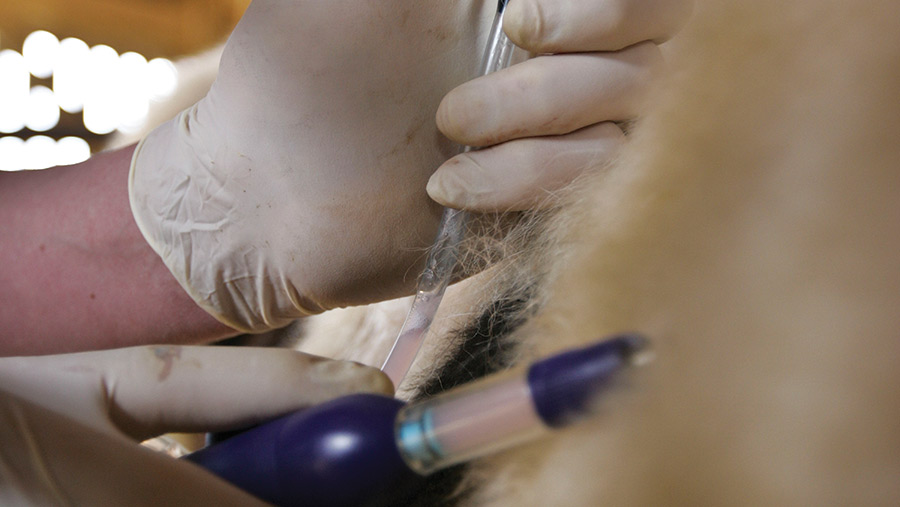Tips on evaluating your dairy vet spend
 © Tim Scrivener
© Tim Scrivener Chatting with a neighbour about vet costs can result in a frantic dash to change vets or cut medicine costs because yours are “too high” in comparison, but that reaction is too hasty as many factors need to be considered to evaluate your vet spend.
Dan Stevenson of LLM Farm Vets and Paddy Gordon of Shepton Vets give advice on how dairy farmers should critique their vet costs.
See also: Dairy farmer cuts vet spend while improving animal health
Analyse your vet medicine spend in detail
Look at exactly where money is going. For example; if you are spending all of your money on “fire-fighting” and treating specific diseases, then what can be done to prevent problems?
If you are spending on preventative measures, such as vaccines, then you are potentially saving disease costs in the long term.
It’s also difficult to look at vet med costs as a fixed cost as things will vary year-on-year.
Although vaccine and sealant use may remain consistent if cow numbers stay the same, there are variable costs that will be linked to disease challenges.
One year a farm may also have used more vet tech services – which may have increased vet costs, but reduced labour costs elsewhere. Therefore, it’s always important to ask first why vet spend has increased.
How to split out your vet costs
- Dry cow medicines (including sealant)
- Preventative medicines – eg vaccines, monensin boluses
- Fees and lab
- Fertility costs – eg synchronisation medicines
- Lactating cow tubes
- Therapeutic medicines – eg antibiotics, non-steroidal anti-inflammatories
- ‘Other’ – eg boluses, wormers and consumables
- Antibiotics can be split into injectables, intramammaries, and other – and then further subdivided into critically important antibiotics (CIA) and non-CIA.
These figures can be used to benchmark farm vet med costs year on year. Talk to your vet about setting farm-specific vet med targets (above categories from LLM Farm Vets’ Vet Invest package).
Set herd-specific targets
There are no specific vet med spend targets for different production systems. Instead, these should be decided on an individual farm basis.
Mr Gordon says 1-1.4ppl is a common vet med cost figure identified in most farm costings, while global figures suggest between 3% and 5% of production costs go on vet spend.
However, he also says it’s not advisable to use this as a target and says instead that targets should be farm-specific.
Mr Stevenson advises sitting down with the farm’s vet, splitting out costs (see box) and benchmarking farm performance against itself. Many vets have a dedicated support package that can help with this.
Focus on preventative measure to protect herd health
He says that focusing on preventative measures will bring long-term benefits and believes every £1 investment in health/disease prevention brings a return of £3 to £4.
Mr Gordon adds: “Every farmer should discuss with their vet what they’re spending money on and where they can both see an opportunity to improve health. Let’s look for the win-win.”
Often a spend in one area can have a knock-on effect in another area. For example, if you’re vaccinating dry cows against calf scours, you will then see a decrease in spend on treatment in their calves.
Understand disease costs, not just the cost of medicines
Having a discussion about return on investment from vet med spend is important.
For example, it may be that an investment of half a day’s vet time – at £500 a day – is needed to investigate why mastitis levels have increased and to get advice on treatment and prevention. However, at £300 a case, if that advice results in two fewer cases of mastitis, you have more than paid for the cost.
Top tips:
- Rather than seeing vet spend being a “cost”, it should be seen as an “investment”
- Having regular joint meetings with the vet, nutritionist and consultant about preventive strategies can also help
- Critique antibiotic use. With Red Tractor and supermarkets already requiring producers to monitor and drive down use of critically important antibiotics (CIA), the momentum for all farmers to do the same is only going to build. Use the AHDB Dairy “University of Nottingham Dairy AMU Calculator” online tool for assessing antibiotic use with the farm’s vet. This compares antibiotic use with RUMA targets (21mg/PCU by 2020) and can be used to identify where savings might be able to be made. View the calculator at dairy.ahdb.org.uk
